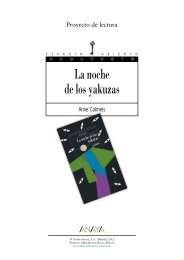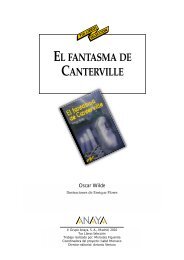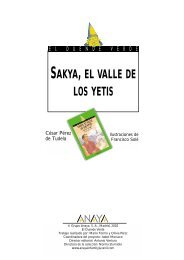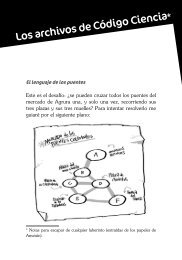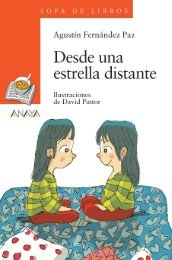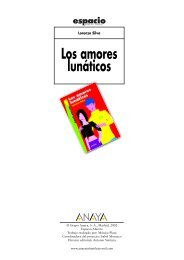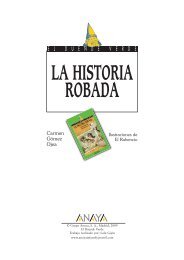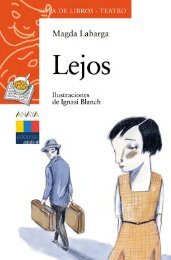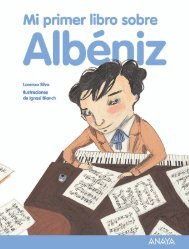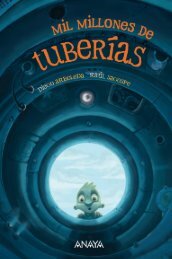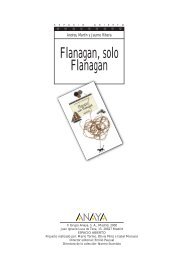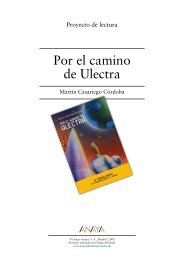Dos monstruos - Anaya Infantil y Juvenil
Dos monstruos - Anaya Infantil y Juvenil
Dos monstruos - Anaya Infantil y Juvenil
You also want an ePaper? Increase the reach of your titles
YUMPU automatically turns print PDFs into web optimized ePapers that Google loves.
<strong>Dos</strong> <strong>monstruos</strong>Two MonstersDavid McKee101
Two Monsters<strong>Dos</strong> <strong>monstruos</strong>Two monsters live on opposite sides of a mountain,and they can’t agree on whether day is beginningor night ending. The monsters insult each otherand throw rocks until they make a surprising discovery.<strong>Dos</strong> <strong>monstruos</strong> viven en caras opuestas de una montaña,y no se ponen de acuerdo en si el día comienzao la noche termina. Los <strong>monstruos</strong> se insultanel uno al otro y se lanzan rocas, hasta que hacenun descubrimiento sorprendente.The AuthorDavid McKee’s first book was published in 1964. He is the creator ofElmer the Patchwork Elephant, as well as both Mr Benn and King Rollo.His books are now published in many languages throughout the world,and many of them have been adapted for television. He is one of theleading contemporary children's book creators.El autorEl primer libro de David McKee fue publicado en 1964. Es el creadorde Elmer, el elefante de colores, y también de Mr Benn y del Rey Rollo.Sus libros han sido traducidos a muchas lenguas en todo el mundo,y muchos de ellos han sido adaptados para televisión. Es uno delos más importantes creadores de libros infantiles en la actualidad.Learning ObjectivesObjetivos didácticos• To promote listening and observational skills.• To recall information from a story.• To show an awareness of story structure and to practise generalreading skills.• To practise the following structures:–What can you see? Who can you see? I can see...–Who am I?• Desarrollar las habilidades visuales y auditivas.• Recabar información de una historia.• Familiarizarse con esquemas narrativos y fomentar la comprensiónlectora.• Practicar las siguientes estructuras:–What can you see? Who can you see? I can see...–Who am I?102 103
Two Monsters<strong>Dos</strong> <strong>monstruos</strong>Introduction• Before the lesson, cut a piece of card to the same size as the book cover. In themiddle of the card cut a hole of approximately 5 centimetres diameter. Place thecard over the front cover of the book so that only a part of the illustration can beseen through the hole. What can you see on the cover? What / who do you think it is?• When the children have guessed with your help, reveal all of the cover illustration.Encourage individual children to describe each monster. Refer to one of the monstersin English and ask the class to guess which one it is i.e. this monster has claws,two round eyes and a horn on his nose. Which monster is it?• Ask the children to tell you what they think the story will be about. Do the monsterslook happy or sad? What will the monsters do? Do you think they are friends? When thechildren respond in their first language translate their ideas in your reply. Alejandrathinks the monsters will play together.• Ask the children to look at how the two monsters are sitting (back to back). Canthey see each other?Reading the Story• Read the story pausing for the children to see the illustrations. When the monstersinsult each other they use many words which the class will not be familiar with.Help the children to capture the meaning and the humour by the use of facialexpression, exaggeration and tone of voice.• Stop at page 12 just before the monsters start to throw stones at each other. Whatdo they think will happen next?• Stop again when the monsters see each other for the first time on page 22. Whatwill they do now?• What does the last picture remind them of (it is similar to the front cover). Showthe class the cover illustration again. What differences can they see between the twoillustrations?Introducción• Antes de comenzar, recortamos una cartulina del mismo tamaño que el libro. En elmedio de la cartulina, recortamos un agujero de aproximadamente 5 cm. de diámetro.Colocamos la cartulina tapando la cubierta del libro, de modo que solo puedanver una parte de la ilustración a través del agujero, y les preguntamos: What can yousee on the cover? What / who do you think it is?• Cuando los niños hayan adivinado qué hay en la cubierta, mostramos toda la ilustración.Les animamos a describir a cada uno de los <strong>monstruos</strong>. Describimos a cadauno de ellos en inglés, y pedimos a los alumnos que lo identifiquen. Por ejemplo:This monster has claws, two round eyes and a horn on his nose. Which monster is it?• Pedimos a los niños que nos digan de qué piensan que puede tratar la historia. Dothe monsters look happy or sad? What will the monsters do? Do you think they arefriends? Cuando los niños contesten en castellano, traducimos sus ideas al inglés. Porejemplo: Alejandra thinks the monsters will play together.• Pedimos a los niños que observen el modo como están sentados los <strong>monstruos</strong>(espalda contra espalda). ¿Pueden verse entre ellos?Durante la lectura• Leemos la historia, haciendo pausas para que los niños se fijen en las ilustraciones.Cuando los <strong>monstruos</strong> se insultan entre sí utilizan palabras con las que los niños noestarán familiarizados. Les ayudamos a entender su significado y el humor mediantegestos, exageraciones, y el tono de voz.• Nos detenemos en la página 12, justo antes de que los <strong>monstruos</strong> empiecen a arrojarsepiedras. ¿Qué creen los niños que sucederá a continuación?• Nos detenemos de nuevo cuando los <strong>monstruos</strong> se ven por primera vez, en la página22. ¿Qué harán ahora?• ¿Qué les recuerda la última ilustración del libro (es similar a la de la cubierta).Enseñamos de nuevo a los niños la imagen de cubierta. ¿Qué diferencias encuentranentre las dos ilustraciones?104 105
Two Monsters<strong>Dos</strong> <strong>monstruos</strong>Follow-up ActivitiesStory partnersAsk the children to sit with a friend, or turn to the person next to them. Explain thatthey have to tell each other if they liked the story and why or why not. Then ask thechildren to answer the following questions with their partner: Why did the two monstersstart fighting in the beginning? Who was right?Back to backShow the cover illustration of Two Monsters again and see if the children can rememberhow to say how they are sitting (back to back). Ask a volunteer to come out to thefront and sit on a chair facing away from the other children. The volunteer will haveto close their eyes or wear a blindfold. Place another chair behind the volunteer facingthe class. Explain that you are going to choose another child to come out and sit onthe chair facing the class. They must then say good morning / afternoon, who am I? Thefirst child has to guess who they are. If the children guess easily the game can be repeatedwith the children disguising their voices.Night and day 1Draw a line to divide the board in two halves. On one side write day and on the otherwrite night. Read the words and point out to the class how difficult they are to spell.Ask the children to study the words for 20 seconds and then rub them out. Ask theclass to tell you how to write them again. Ask children to come and draw symbols fornight and day on each side i.e. sun and moon. Say various activities and actions andask the children to point and say which side of the board they correspond to i.e. sleeping,eating breakfast, going to school etc.Después de la lecturaCompañeros de historiaPedimos a los niños que se sienten con un amigo, o con el compañero que tengan allado. Explicamos que tienen que decirse uno a otro si les ha gustado la historia o no,y los motivos. Después les pedimos que respondan a las siguientes preguntas con sucompañero: ¿Por qué los dos <strong>monstruos</strong> empiezan a discutir? ¿Quién llevaba razón?Compañeros de espaldaEnseñamos la ilustración de cubierta del libro y comprobamos si los niños recuerdancómo se dice en inglés el modo en el que están sentados (back to back). Pedimos unvoluntario para salir a la pizarra y sentarse de espaldas a sus compañeros. El voluntariotendrá que cerrar los ojos o ponerse un pañuelo que le impida ver. Colocamos otra silladetrás del voluntario, mirando hacia la clase. Explicamos que vamos a escoger otroniño para que salga y se siente en ella, de cara a sus compañeros. El segundo voluntariodebe entonces decir: Good morning / afternoon, who am I?, y el primero debe adivinarquién es. Si los niños lo adivinan fácilmente, se puede realizar el ejercicio impostandolas voces.Día y noche (1)Trazamos una línea que divida la pizarra en dos mitades. En un lado escribimos day, yen el otro night. Leemos las palabras, y mostramos a la clase lo difíciles que son de deletrear.Pedimos a los niños que observen las palabras durante veinte segundos, y luegolas borramos. Pedimos a los alumnos que digan cómo se escriben. Luego les pedimosque salgan a la pizarra y dibujen en cada lado símbolos que representen el día y lanoche (por ejemplo, un sol y una luna). Nombramos a continuación diversas actividades,y los niños tienen que decir en qué parte las clasificarían. Por ejemplo: sleeping,eating breakfast, going to school, etc.106107
Two Monsters<strong>Dos</strong> <strong>monstruos</strong>Ideas for Further ActivitiesNight and day 2Explain to the children that you want them to draw a picture of night and day. Ifpossible show them images of night time and day time and discuss the differencesbetween them. Afterwards, give each child a large sheet of paper and demonstrate howto fold the paper in half. Ask the class to draw on each half their own pictures ofsomething they do at night and something they do in the daytime.Story DisplayAsk the children to work in small groups. Give two groups a large sheet of paper andcolours. Ask one group to draw a large picture of the red monster and the other groupto draw a large picture of the blue monster. Give the other groups some scissors andbrown paper or newspaper and ask them to cut out large rock shapes for the mountain.Use their work to make a display about the story Two Monsters.Actividades complementariasDía y noche (2)Explicamos a los niños que queremos que hagan un dibujo sobre la noche y el día. Sies posible, les enseñaremos distintas imágenes sobre la noche y el día, y hablaremos delas diferencias que hay entre ellas. Después, le damos a cada niño una hoja de papel yles mostramos cómo doblarla en dos. A continuación les pedimos que dibujen en unade las mitades del papel algo que hagan por la noche, y en la otra algo que hagan porel día.CartelPedimos a los niños que formen pequeños grupos. Les damos a dos grupos sendashojas de papel, y lápices de colorear. Pedimos a uno de los grupos que dibuje al monstruorojo, y a otro que dibuje al monstruo azul. Al resto de los grupos les damos unastijeras y papel de embalar o de periódico, y les pedimos que recorten rocas para hacerla montaña. Con todos los elementos, construimos un cartel sobre el libro.108109



